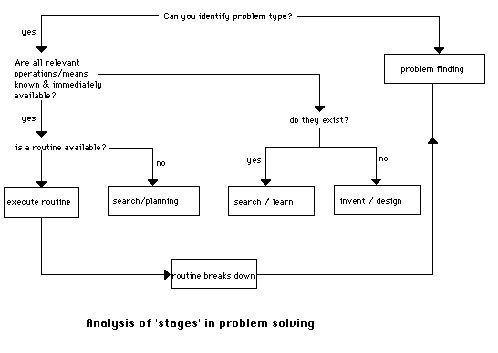
You ask yourself a series of questions designed to find out what you know about the difficulty facing you: 5 W/H (who, what, where, when, why & how; simple and effective). On basis of your answers you can classify your stage of problem solving. Real care should be paid when everything is known, both problem and solution. You are then on the routine track and no creative thinking plays a role. But there such situations for instance a flat tire. Still don't waste the opportunity to invent the instant tire repair kit.
Where you can already identify the type of problem facing you, know the operations that will transform the initial state of affairs into the desired one and have available a known technique for organizing these operations successfully, your task is really one of groundwork rather than problem solving, i.e. executing a routine from memory. A 'problem' may mean no more than rectification of mechanical trouble e.g. a loose battery lead of a car, and is no real problem, but just a rather boring job to do. Often so-called problems present an opportunity to deal with a situation. Once you feel the need to do something about it it has become a challenge. The 'problem' has not changed but your way of looking at it.
If you know exactly what the goal is and are confident that you have at hand the means to achieve it but do not have a worked-out routine, your problem is a planning one, with perhaps an element of search, i.e. integrating the operations into an appropriate sequence to fit the demands of the specific problem context. Many so-called problems are of this type - planning a difficult itinerary, winning a game like chess, trying to do two things at once and so on.
If you do not have at hand the necessary tools or operations to achieve a known goal and you can identify that transformations needed, the task is one of search. If you know that the tool does not exist, your challenge is one of improvisation - invention or design - i.e. producing an object or a procedure that meets clearly formulated constraints and will do the job.
Of course, there are many troubles that we face where we cannot even identify the nature of difficulty and hence cannot start to decide what is relevant to our problem-solving needs. Then we are faced with problem finding, i.e. transforming our vague sense of difficulty into an articulate problem or puzzle for which we can start to design or recruit operations for solution. Problems in science and art are often of this type.
An individual observes a phenomenon or a pattern of events that does not fit in with existing laws or assumptions - a difficulty whose significance cannot be fathomed and that leads to a sense of 'trouble', a sense that there is something to be explained. This difficulty may need to be followed up for weeks or even many years before it can be articulated into a real problem.
This 'trouble' is often experienced when existing routines break down. Our routines are so integrated into our ways of going on that they are particularly difficult to identify. Just as we may expect a fish to be the last to discover water, so we are likely to be late in identifying and restructuring our own mechanisms of behaviour.
When starting out for creativity it is wise to make an inventory of one's routines and then consciously deviate from them. For a routine more often than not means a block and once blocks are known they are not dangerous.